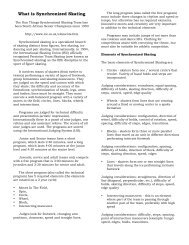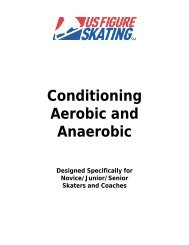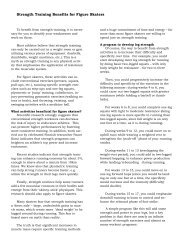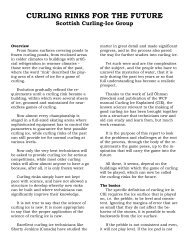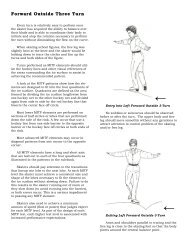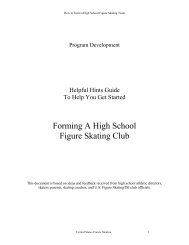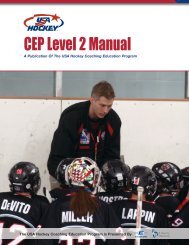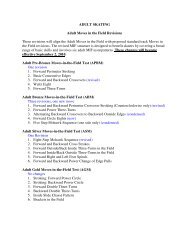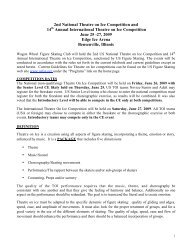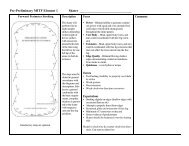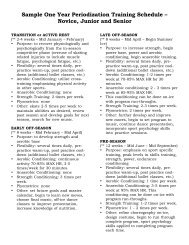CEP Level 3 Manual - Rushmore Hockey Association
CEP Level 3 Manual - Rushmore Hockey Association
CEP Level 3 Manual - Rushmore Hockey Association
Create successful ePaper yourself
Turn your PDF publications into a flip-book with our unique Google optimized e-Paper software.
T A B L E O F C O N T E N T SSuggestions for CoachingLEG SAVESFigure 6. Poke Check.The goalie should use a stick that is appropriatefor their side and skill level. When the stick is laggingbehind on moves and/or saves it usually signals thatthe size is too large and should be downsized.Key Elements• Grip position of the stick• Firm but not clenched grip• Maintain the cushion between the stick andthe skates• Maintain the basic stance and correctpositioning• Back up the stick with the skate(s)Common Errors• Failing to maintain the basic stance positionwhile stationary or moving• Failing to maintain the cushion between theskates and the stick• Kicking the stick to deflect a puck• Dropping to knees behind a stick saveresulting in poor positioning for the next shotBe sure your goalies learn to execute the correcttechnique when executing stick saves on slowmoving pucks before expecting them to stop hardshots. Gear your practices to give them successwith easier saves and then gradually increase thespeed and therefore, the difficulty of the saves.BODY SAVESThe ultimate objective for goaltenders is to gettheir body in front of the puck on every shot.Realizing this is not always possible, glove, pad andstick saves are also used. However, if young goaliesstart with the objective of moving their body in frontof every shot, they will find that their other saveoptions will also improve.Key Elements• Maintain the basic stance and correctpositioning• Stay between the goal and the puck• Keep eyes on the puck as long as possible• Anticipate the shotCommon Errors• Failure to maintain the basic stanceand correct positioning• Relying on the stick rather thanthe body• Weight moving away from the puckSuggestions for CoachingWork on technique first. Start slowly andincrease the difficulty of the saves as goaliesimprove. Be sure to cover priorities within saves.First, follow the puck. Second, make the save. Third,cover and control the puck.GLOVE SAVESTeach your goalies to keep their wrists firm butflexible when catching the puck (soft hands). Also,they must keep their eyes on the puck. Themajority of shots above the knees on the stick sideshould be stopped with the blocker. The catchingglove should be brought across the body and overthe blocker to trap the puck to prevent a rebound.Figure 7 illustrates this move.Figure 7. Trapping the puck with theglove and blocker.Key Elements• Proper initial position of glove (open, aroundknee high, ahead of the body and filling opennet)• Shift of body weight toward puck• Eyes follow puck into glove• Close the glove• Off-speed shots should be backed up withthe body• Blocker deflects shots to sideCommon Errors• Poor glove position• Initiating the save with a closed glove• Eyes stay with shooter rather than the puck• No shift of body weight (moving only theglove to the puck)• Deflecting shots to the front of the netSuggestions for CoachingFocus on technique first. Movement and saveactions are critical and should be learned first witheasy shots, then with difficult shots. Most younggoalies can learn proper techniques and developgood habits by stopping thrown, rather than shotpucks in practice. Start here and advance to shotpucks as ability improves.The legs (pads) are used mainly for blocking theangle to the net, low shots directly at the goalie, andlow corner shots that are above the stick but too lowto catch.Teach goalies to not kick at a shot directly atthem as it may result in a rebound to the front of thenet. Instead the pads are also used to cushion shotsto fall to the feet and prevent rebounds. To cushiona shot, goalies should raise the hips slightly, thusstraightening the knees. It is critical that thisstraightening occur at the same time the puck ishitting the pad. The straightening allows forredirecting the flight of the puck downwardresulting in the cushioning effect (puck falling at feetfor easy cover-up). This is illustrated in Figure 8.When shots are to one side or the other, thegoalie’s pads are the only weapons they have. Inthis case, teach your goalies to kick the puck withthe leg pad, following through to direct it to thecorner or sideboard.Figure 8.Key ElementsCushioning a shot to fall tothe feet.• Maintain the basic stance and correctpositioning• Watch the puck all the way to impact• Deflect the puck to the side when it can notbe trapped• Cushion the puck impact so the puck falls atthe feet on direct shots for easy cover-up• Trap the puck with the glove when possibleto prevent rebounds286 | USA <strong>Hockey</strong> Coaching Education Program <strong>Level</strong> 3 <strong>Manual</strong>Goaltending | 287



